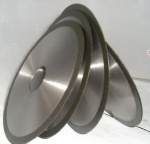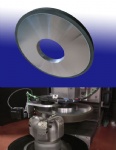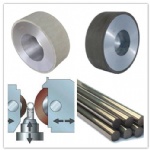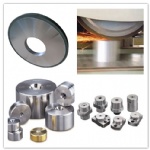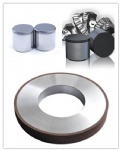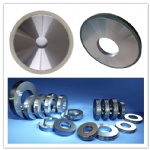The improved techniques in electric discharge machining are important factors in the emergence of tungsten carbide as a die material. Another equally important development is the improvement in grinding equipment and techniques, and diamond wheel techniques. Without such improvements the maintenance of progressive carbide dies would be impossible.
Unlike most too-steel progressives, which can be sharpened on almost any type of surface grinder, a carbide die requires the very best in grinding equipment. This includes a machine large enough to carry the comparatively heavy weight of lower die. (Normally, the entire die is placed on the surface grinder, whereas in conventional sheet-metal progressive dies, the blanking and piercing details are removed from the die for sharpening.)
Grinders equipped with diamond wheels
Grinders that mount a peripheral-type diamond wheel are preferable to those with vertical spindles for grinding carbide dies. The vertical type, using diamond cup wheels, covers a greater portion of die than the horizontal (peripheral) type, generating higher heat levels and impairing visibility. Regardless of the type of grinder used for sharpening carbide dies, the grinder should have a sturdy spindle which runs true on good bearings. All sources of vibration within machine should be located and eliminated. External sources of vibration must be isolated from the machine by dampeners, because vibration from any source has the same effect on surface finish as an unbalanced wheel.
The coolant is more important in the grinding of carbide than in any other material. Its flow should be uninterrupted and heavily directed at the point of contact. While maintaining a uniform temperature in the work-piece, it also washes away the grit produced by grinding. This is important in reducing wheel “load-up” with its attendant glazing and chatter. In selecting coolants it is important that the die grinder avoid those containing sulfur. Sulfur will chemically attack both the cobalt used to sinter the carbide and the resins used for bonding in the wheel.
Diamond Grinding Wheels
A resin bond diamond wheel of proper grit should be used for grinding carbide dies. Green grit wheels should be avoided because they present too many hazards to the die. An ideal combination of wheels for grinding carbide would consist of a 100-grit wheel for roughing and a 180-grit for finishing. However, the use of a 150-grit wheel for both roughing and finishing is practical. Whether the combination of wheels or the all-purpose wheel is used, all wheels should have the same general specifications other than grit size. These would include a diamond concentration of 100 and bonding hardness.Peripheral speed of grinding wheel should be approximately 4200 surface feet per minute (sfpm)(1260 surface meters per minute - smpm) with table speeds of approximately 85fpm(25.5mpm) for roughing cuts. Speed should be increased above 85fpm for finishing. Cross-feeds of 0.25 inch to 2.7 inch (6.3mm to 69mm) are correct for roughing cuts. For finishing cuts the cross-feed should be reduced to 0.03inch (0.8mm).
Diamond Wheel Run-out
After the diemaker has selected the proper machine and wheel for grinding a carbide die, he or she should inspect both he spindle and adapter for runout. This can be done with a dial indicator mounted on a surface gage or height gage.. Any burrs which may interfere with wheel fit should be stoned. When the wheel is mounted on the adapter, the diemaker should be certain that the hold and adapter mate in such a manner that the wheel can come to rest against the shoulder.
Diamond Wheel Dressing
For initial and all subsequent dressings of the wheel a brake-controlled dresser is recommended. This dresser is should have a silicon-carbide wheel of the following specification: 37C60Q5V Norton or equivalent (dimensions: 3-inch (76mm) diameter; 1-inch (25mm) face; 0.5-inch(13mm) bore).
The dresser should be placed at some convenient place on the grinder table with its spindle parallel to the spindle of the grinder; its wheel should ravel in line with the direction of travel of the diamond wheel. When the brake-controlled dresser is properly set, it will travel at approximately 1500 sfpm(450smpm) when driven by contact with the diamond wheel traveling at normal speed.
Before he dressing wheel is brought in contact with the diamond wheel, it must be set in motion. This is important; if the dresser is not spinning, the diamond wheel will grind a flat on it, causing permanent damage. A small wood stick can be used to set the dresser wheel in motion. Some lamination diemakers add a knurled knob to the dresser spindle. This knob provides increased efficiency as well as improved safety.
The diamond wheel should be passed over the dressing wheel by means of the cross-feed. All dressing is done without the use of coolant. Downfeeds not exceeding 0.001 inch (0.025mm) should be taken at each pass with the diamond wheel clearing the dressing wheel each time. After a downfeed of 0.005 in (0.13mm) has been made, the diamond wheel should be stopped and examined for results. This action should be repeated if necessary until the diamond wheel is dressed true and smooth. This accomplished, the color of the wheel will be the same over its entire face. The purpose of this operation is to dress away the wheel bond, thereby truing the wheel and exposing the diamond particles. Cleaning sticks supplied by wheel manufactures should be used frequently to keep the wheel opened.
Sharpening Tungsten Carbide Dies
When a carbide die is ready for sharpening, it should be cleaned of all oil, slugs, and foreign material. All burrs should be removed from both the chuck and die shoe to ensure that the die will lie flat.
Cutting edges should be inspected to determine the amount of stock that must be removed. If excessive wear or chippings is a localized condition, it may be expedient to raise or replace that particular section to avoid grinding the entire surface of the die.
When the die has been placed on the chuck, the stops should be set so that the work will pass at least 1.0 inch (25mm) beyond the wheel. The cross-feed and speed should be set as noted previously, and the grinding can begin. There are, of course, no sparks when carbide is ground with a diamond wheel. In this form of grinding, the diemaker listens for a light hissing sound which indicates wheel contact with the work.
After initial contact has been made, the wheel should be raised 0.002 inch(0.05mm) before it is again brought in contact with the work. It should then be down-fed in increments of 0.002inch(0.005mm) for roughing cuts and in increments of 0.001 inch(0.003mm) for finishing. It is also important that the wheel be permitted to make at least two free passes over the work between feeds.
To establish the required depth of cut, some grinder hands “plunge grind” at the point showing greatest wear. They then cross grind until the path of the plunge cut is removed. If the total amount of grind is to exceed 0.010 inch (0.25mm), an aluminum oxide wheel should be used remove as much of the shoe and die material as possible. This should be done to save the wheel, because steel will cause a diamond wheel to break down faster than with carbide.
Grinding of the upper die is performed in a similar manner except that small perforating punches must be supported. This support can be given in one of two ways: use of stripper and use a strip from a previous run. Using a stripper presupposes very close support of the punches by the stripper, which is fitted in place without its springs. Resting on parallels, it proves most effective as a means of supporting small punches during grinding.
Using a strip from a previous run is a much less desirable method. The strip can be fitted over the punches and do an adequate job; however, the use of a strip instead of a stripper is dangerous in that it is easy to chip or fracture when the strip is put on or removed.
Whichever method is used for die sharpening, it is necessary that punch exposure be kept a minimum. The brittleness of carbide makes it an almost delicate material.



